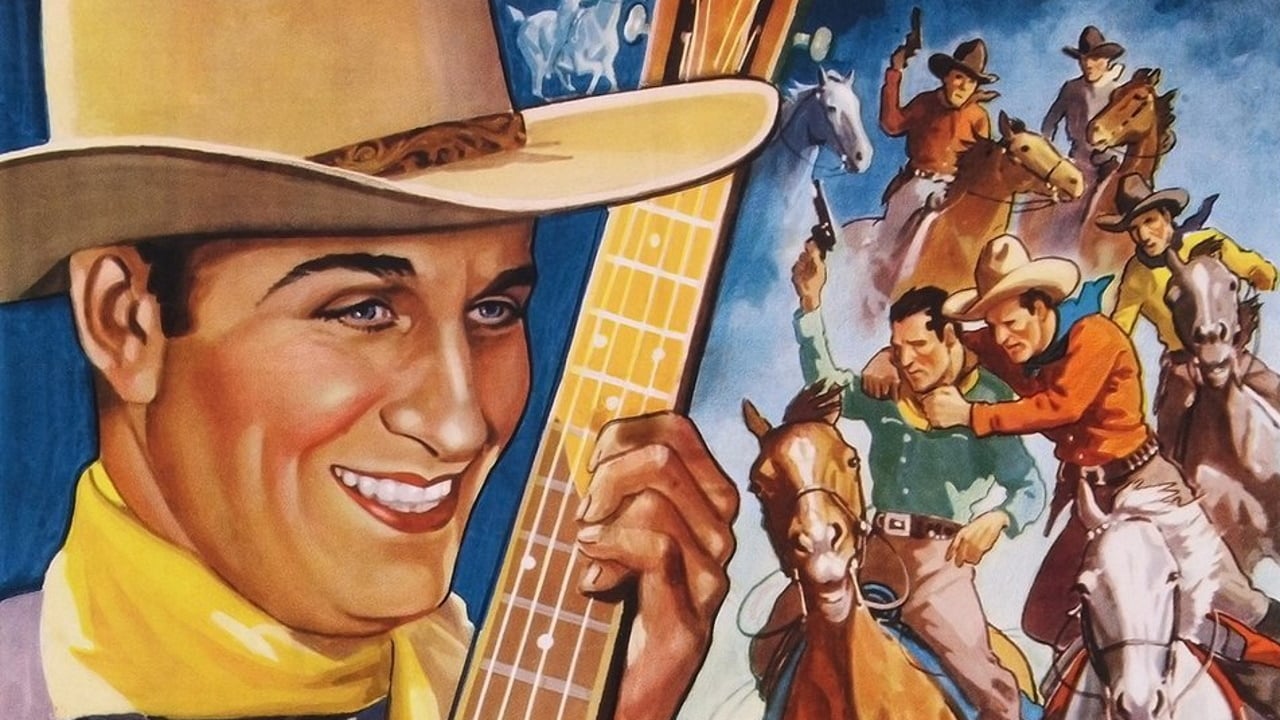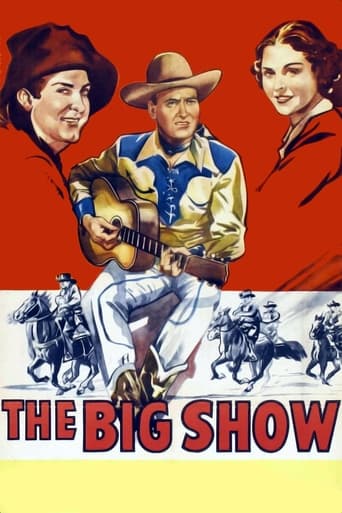

Up till now I thought the only film in which Roy Rogers appeared with Gene Autry was "The Old Corral". Not that it was much of an appearance, as he shows up briefly in three of Gene's singing numbers as a guitarist with the Sons of the Pioneers. Even though he's uncredited, it's still cool to see him show up here.But this is Gene's picture all the way, and he appears not once, but twice, as a stunt double for the nominal star of Mammoth Pictures, Tom Ford. The fake Ford isn't around much for the picture as he goes off on a fishing trip, but his hassle with a trio of gangsters who he owes ten grand to is made part of the story line. Gene also finds himself in a couple of romantic entanglements, one on behalf of Ford and one of his own doing. It's not really as complicated as all that, as you can follow the action along pretty easily as things get under way.Apparently, the picture got some mileage as a publicity vehicle for the Texas Centennial of 1936 in Dallas. Quite a few singing groups make their way into the story, including the Light Crust Dough Boys (love that name!), the Jones Boys, the Beverly Hillbillies, and of course, the Sons of the Pioneers. Only the Pioneers get to do more than a single tune, and of course Gene himself has a host of musical numbers.Gene's sidekick here is Smiley Burnette, but he's not the only one with a comedic role. Max Terhune's on board as well, along with his wooden buddy Elmer. Surprisingly, Terhune has the ventriloquist gimmick down pretty well, as his lips hardly ever move while speaking for Elmer, even while delivering a song of his own."The Big Show" is a fairly entertaining Western flick and a nice showcase for a numbers of B Western players from the mid Thirties. It's also the only film in which that running horse mount from behind is mentioned by name; Gene calls it a Crupper Mount. Smiley apparently was impressed enough to get one done by his third try at the end of the picture. By that time, Gene was closing things out in a smooch with Kay Hughes who played his romantic interest Marion Hill.
... View MoreLet's get the plot out of the way first. Gene plays a double role as a bad tempered cowboy star, Tom Ford (who has large gambling debts and a blonde fiancée) and his stunt double. Gene winds up impersonating Ford at the Texas Centennial of 1936, as a cowboy and a singer, even though Ford can't sing. We expect some identity mixups and we get them. The fiancée and the gamblers appear to cause trouble and a final chase scene, but the film mostly centers around the Centennial. It's an unusual Western because it was filmed during the Centennial celebration at Fair Park, where we see many shots showing the abundance of deco buildings and statues. They're all still there, as it is now called the Texas State Fairgrounds. What a setting for a picture! We see a cast of thousands! The parades, the stadium crowds, and the outdoor staged 'panoramas' that were a common part of expositions and World Fairs from before to after the turn of the century, even up to the late forties. We see the Western cavalcade, the Texas Six Flags, and Gene's singing farewell to his 'wounded' horse Champion. It's definitely a musical Western, because the story elements fly by, especially in the 54 minute edited version found in most remainder bins (such as Platinum's 'The Great American Western Volume 5' DVD, which is the version I have.) The performance of 'The Lady Known as Lulu' by the black 'Jones Boys' is missing from the 54 minute versions. The official, restored 71 minute version has 10 songs, but only two are halfway decent (both ballads, 'Mad About You' and Jimmie Davis's 'Nobody's Darlin' But You').Other highlights: Kay Hughes is the female lead. Gene apparently likes wholesome looking girls, since she was also in 'Ride, Ranger, Ride' (1936). She plays Gwen in the first Dick Tracy serial (1937), and the spunky Molly Selkirk in 'Radio Patrol' (1937). Contrary to what most people say, here's a film where Gene actually does kiss the girl at the end of the movie, but with the vocal track still going, he's singing while he does it! Another lowlight: Gene is clearly not a stunt man. In the scenes where he's supposedly stunting for Ford, he can be seen several times carefully, warily, and worriedly looking for his safety hand holds. And of course, he's all too obviously doubled for in the fight sequence in the hotel with the evil gambler Collins (Rex King).William Newell seems to get as much screen time as Gene; his other big role is as Mala's helper Hank in 'Robinson Crusoe of Clipper Island' (1936), but after that he went on to a distinguished career as an uncredited bystander in hundreds of movies and TV shows.We get our standard sidekicks Smiley Burnette and Max Terhune (this time doing his ventriloquist act), the Beverly Hillbilles as Gene's backup group, fresh from 'The Phantom Empire' (1935), and the Sons of the Pioneers with the twinkling smile of Roy Rogers (Leonard Slye), a rhythm guitarist in the back row.Full of historical interest, it's an enjoyable diversion despite the weak music, but as a film it's just a four.
... View MoreIn this movie, Gene Autry is a stunt man for Tom Ford, and then does a stand-in for Ford at a Texas Centennial celebration when Ford goes on a fishing trip. At the end of the movie Gene is the star and Tom Ford is now his stunt man.But look! When the Sons of the Pioneers do their singing part in the back of the wagon, who is the guy singing, right front? Why, it's Leonard Slye, one of the original members of the Sons of the Pioneers.The movie was filmed in 1936. Five years later, when Gene Autry left the studio to serve in World War II, the studio needed another singing cowboy and Leonard Slye was chosen. Of course, the studio had to change his name, so Leonard became Roy Rogers.
... View MoreThe likable Gene Autry plays a dual role and has some good opportunities to use his variety of talents in this enjoyable B-Western. The story is light but entertaining, and it has some good musical numbers plus some comic relief from Smiley Burnette. The Texas Centennial setting also gives it some additional historical interest.Autry plays both a bad-tempered movie star cowboy and his talented, good-natured stunt double, so the setup offers some good lighter moments in its look at the movie industry. The story starts with the stunt double filling in for the star at a public appearance, with numerous complications arising from there. Autry gets many opportunities to sing, and there are also some good action sequences.Most of it works pretty well, because it generally allows Autry to use his strengths. Burnette also gets some good moments, and while the story is mostly used to showcase Autry and the other musical entertainment, it works too as a way of pulling things together.
... View More